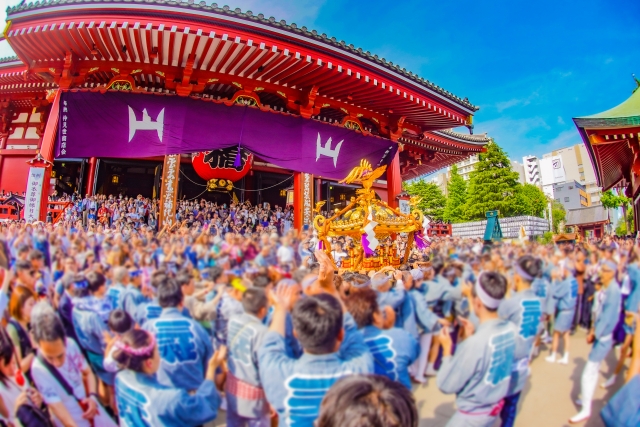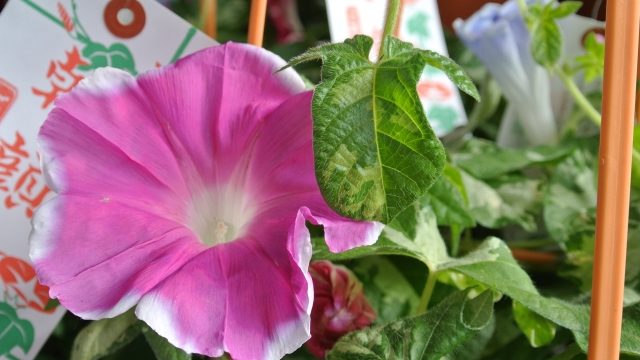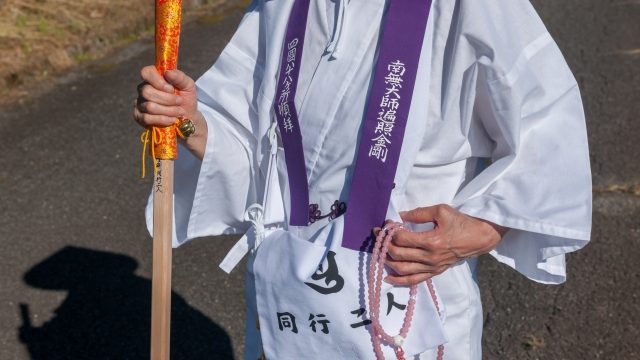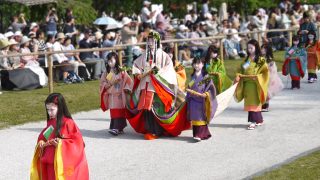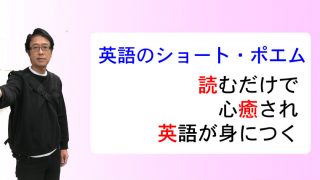浅草神社の「三社祭」は、東京の下町文化を象徴する日本三大祭りのひとつです。
毎年5月に開催されるこの祭りでは、神輿の担ぎ手たちの熱気と活気あふれる姿が、江戸っ子の粋と誇りを今に伝えています。
この記事では、アメリカ人の友人に三社祭の歴史や魅力を英語で紹介する際に役立つ表現を
ご紹介します。日本の伝統的な祭りの躍動感と独特の魅力を、言葉の壁を超えて伝えるためのガイドとしてお役立てください。
三社祭とは?基本的な英語表現
三社祭は英語では「Sanja Festival」または「Sanja Matsuri」と呼ばれます。アメリカ人の友人に説明する際に役立つ基本的な英語表現をいくつかご紹介します。
「三社祭は毎年5月の第3金曜日から日曜日にかけて開催される東京最大の祭りの一つです」 “The Sanja Festival is one of Tokyo’s largest festivals, held annually from the third Friday to Sunday in May.”
「この祭りは浅草神社の祭礼で、700年以上の歴史があります」 “This festival is a celebration of Asakusa Shrine and has a history of over 700 years.”
「三社祭という名前は、浅草神社に祀られている土師真中知命、桧前浜成命、檜前武成命の三柱の神に由来しています」 “The name ‘Sanja Matsuri’ derives from the three deities enshrined at Asakusa Shrine: Hinokuma Hamanari, Hinokuma Takenari, and Hajinari Nakatomo.”
「三社祭は毎年約200万人の観光客を集める東京の主要な観光イベントです」 “The Sanja Festival is a major tourist attraction in Tokyo, drawing around 2 million visitors each year.”
三社祭の歴史と起源
三社祭の歴史的背景について説明する際の英語表現です。
「三社祭の起源は628年に遡り、隅田川で漁をしていた漁師が観音像を発見したという伝説に基づいています」 “The origins of the Sanja Festival date back to 628, based on the legend of fishermen discovering a statue of Kannon in the Sumida River.”
「この発見を記念して浅草寺が建立され、後に浅草神社も創建されました」 “To commemorate this discovery, Sensoji Temple was built, and later Asakusa Shrine was established.”
「現在の形での三社祭は、江戸時代(1603-1868)に徳川家康によって正式に認められました」 “The Sanja Festival in its current form was officially recognized by Tokugawa Ieyasu during the Edo period (1603-1868).”
「明治時代には一時的に規模が縮小されましたが、戦後に再び盛大に行われるようになりました」 “During the Meiji era, the scale of the festival was temporarily reduced, but it became grand again after World War II.”
三社祭の神輿と担ぎ手
三社祭の中心的存在である神輿と担ぎ手について説明する英語表現です。
「三社祭のハイライトは、重さ約1トンの本社神輿(ほんしゃみこし)三基が町内を練り歩く様子です」 “The highlight of the Sanja Festival is the procession of three main portable shrines (honsha-mikoshi), each weighing about one ton, through the town.”
「神輿は『神様の乗り物』と考えられており、担ぐことで神様の祝福を町にもたらすと信じられています」 “Mikoshi are considered ‘vehicles of the gods,’ and it is believed that carrying them brings divine blessings to the town.”
「担ぎ手たちは『わっしょい!わっしょい!』と掛け声をかけながら神輿を担ぎます」 “The carriers shout ‘Wasshoi! Wasshoi!’ as they carry the mikoshi.”
「本社神輿に加えて、町内会ごとに約100基の町内神輿が出ます」 “In addition to the main mikoshi, there are about 100 smaller neighborhood mikoshi representing each local community.”
「多くの担ぎ手は『江戸褌(えどふんどし)』と呼ばれる伝統的な下着と『祭り半纏(はんてん)』を身につけています」 “Many carriers wear traditional undergarments called ‘Edo-fundoshi’ and festival coats called ‘matsuri hanten.'”
「神輿を担ぐことは名誉とされ、地元の人々だけでなく、様々な背景を持つ人々が参加します」 “Carrying a mikoshi is considered an honor, and not only locals but also people from various backgrounds participate.”
三社祭の流れとハイライト
三社祭の3日間の流れとハイライトについて説明する英語表現です。
「三社祭は金曜日の宵宮祭(よいみやさい)から始まり、日曜日の本社神輿の渡御(とぎょ)でクライマックスを迎えます」 “The Sanja Festival begins with the Yoimiya-sai ceremony on Friday and reaches its climax with the procession of the main mikoshi on Sunday.”
「土曜日には、浅草神社から出発する華やかな『神幸祭(しんこうさい)』の行列があります」 “On Saturday, there is a colorful procession called ‘Shinkosai’ that departs from Asakusa Shrine.”
「日曜日の朝には、三基の本社神輿が浅草神社を出発し、浅草の街を一日かけて練り歩きます」 “On Sunday morning, the three main mikoshi depart from Asakusa Shrine and parade through the streets of Asakusa throughout the day.”
「各町内会の神輿が集まる『宮入(みやいり)』は、三社祭の最も活気に満ちた場面の一つです」 “The ‘Miyairi,’ where neighborhood mikoshi gather, is one of the most energetic scenes of the Sanja Festival.”
「祭りの間中、浅草寺の周辺では屋台が立ち並び、日本の伝統的な祭りの食べ物や遊びを楽しむことができます」 “Throughout the festival, food stalls line the area around Sensoji Temple, offering traditional Japanese festival foods and games.”
三社祭を観る際のポイント
外国人の友人と一緒に三社祭を楽しむためのアドバイスと英語表現です。
「三社祭は非常に混雑するので、早朝に行くか、主要ルートから少し離れた場所で見ることをお勧めします」 “As the Sanja Festival gets very crowded, I recommend going early in the morning or watching from a spot slightly away from the main routes.”
「神輿の担ぎ手たちの写真を撮る際は、安全な距離を保ち、祭りの進行を妨げないようにしましょう」 “When taking photos of mikoshi carriers, maintain a safe distance and avoid obstructing the progress of the festival.”
「浅草駅は非常に混雑するので、田原町駅や蔵前駅などの近隣の駅を利用するのも良いでしょう」 “As Asakusa Station gets very crowded, you might consider using nearby stations such as Tawaramachi or Kuramae.”
「祭りの詳細なスケジュールは浅草神社の公式ウェブサイトで確認できます」 “Detailed schedules of the festival can be found on the official website of Asakusa Shrine.”
「伝統的な祭り衣装を着た人々や、入れ墨を公開している人々の写真を撮る際は、事前に許可を得るのがマナーです」 “When taking photos of people in traditional festival attire or those displaying tattoos, it’s good manners to ask for permission first.”
三社祭にまつわる文化と伝統
三社祭に関連する文化的側面について説明する英語表現です。
「三社祭は単なるお祭りではなく、地域コミュニティの絆を強める重要な役割を果たしています」 “The Sanja Festival is not just a festival but plays an important role in strengthening community bonds.”
「浅草は江戸時代から続く下町文化の中心地で、三社祭はその伝統を色濃く反映しています」 “Asakusa is the center of downtown culture that has continued since the Edo period, and the Sanja Festival strongly reflects this tradition.”
「祭りに参加する地元の人々は、自分たちの町会の誇りと伝統を次世代に伝えています」 “Locals participating in the festival are passing down the pride and traditions of their neighborhood to the next generation.”
「日本の祭りでは、神様を喜ばせるために騒々しくすることが許されます。これを『神賑わい(かみにぎわい)』と言います」 “In Japanese festivals, making noise is allowed to please the gods. This is called ‘kami-nigiwai.'”
「江戸っ子(古くからの東京の住民)の『粋(いき)』と『威勢の良さ』は、三社祭で最も顕著に表れます」 “The ‘iki’ (stylishness) and high spirits of Edo-ko (longtime Tokyo residents) are most prominently displayed during the Sanja Festival.”
三社祭の現代的意義
現代における三社祭の意義について説明する英語表現です。
「三社祭は伝統を保ちながらも、時代とともに変化し、現代の東京の多様性を反映しています」 “While maintaining tradition, the Sanja Festival has evolved with the times and reflects the diversity of modern Tokyo.”
「近年では、外国人観光客や日本の他の地域からの訪問者も祭りに参加するようになっています」 “In recent years, foreign tourists and visitors from other parts of Japan have also begun to participate in the festival.”
「三社祭は東京の観光業にとって重要なイベントであり、地域経済に大きく貢献しています」 “The Sanja Festival is an important event for Tokyo’s tourism industry and contributes significantly to the local economy.”
「伝統行事でありながら、SNSなどの現代的なメディアを通じて世界中に発信されています」 “While being a traditional event, it is being shared worldwide through modern media such as social networks.”
「三社祭は、急速に変化する東京において、人々が自分たちのルーツとつながる貴重な機会を提供しています」 “The Sanja Festival provides a valuable opportunity for people to connect with their roots in a rapidly changing Tokyo.”
まとめ
三社祭は、単なる観光イベントを超えた、日本の伝統文化と地域コミュニティの結束を象徴する素晴らしい祭りです。
700年以上の歴史を持ち、今なお東京の下町で脈々と受け継がれるこの祭りは、アメリカ人の友人にも必ず深い印象を残すでしょう。
浅草を訪れる際には、ぜひ5月の三社祭の時期に合わせて旅行計画を立ててみてください。
神輿を担ぐ人々の熱気、「わっしょい!」という掛け声、祭りの音と匂いに包まれた浅草の街並みは、日本文化の生きた体験となるはずです。
この記事で紹介した英語表現を活用して、三社祭の魅力を世界中の友人に伝えてみてください。
外資系企業への英語面接サポート・サービスで不安を解消しましょう!
stephenpong.com では、おひとりおひとりに合わせて
英語面接のサポートをレジュメの作成段階からご指導致します
まずは、お問い合わせください
自分で用意した英文レジュメはこれでいいのかな?
英語面接の質問とその答え方はどう準備したらいいの?
英語の面接に不安を感じる、模擬面接で練習したい?!
これらのお悩みをすべて解決します!
お気楽に下記フォームからご相談ください!
人生を動かしましょう!
ごく稀に、返信メールがお客様の迷惑フォルダに紛れ込んでいる場合がありますのでご注意ください。
